What types are there?
Dragon tree, Lucky bamboo – this houseplant is called by many different names. The exotic received its original names due to the structure of its stem with horizontal crossbars. And the tropical guest has the “status” of a Lucky Plant according to Eastern legends and traditions.
In the scientific classification, indoor bamboo belongs to Dracaena sanderiana.
Reference. Dracaena sanderiana (from Latin Dracaena sanderiana) is an evergreen woody perennial. It is a representative of the Asparagus family, genus Dracaena.
A distinctive feature of all varieties of the plant is a massive thickened stem of a rich green or grayish hue. The crown is formed by smooth, oblong, lanceolate leaves.
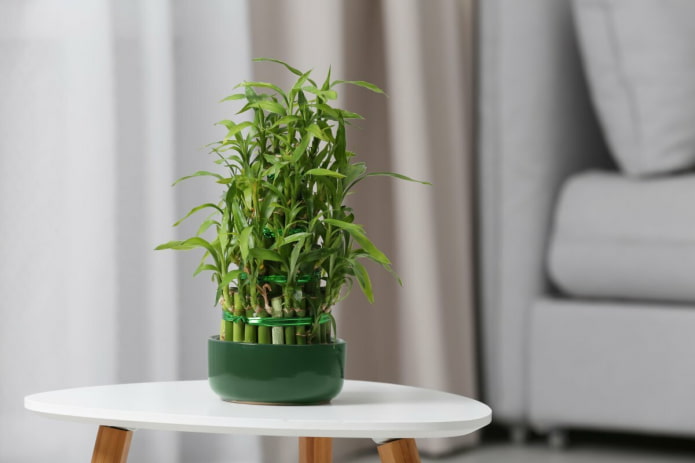
Bamboo is a shrub. The shoots are straight, grow vertically, and branch at the base. At home, the stems usually do not grow more than a meter.
All varieties of Dracaena Sanderiana are conventionally classified by the height of the shoots.
Low-growing species
A characteristic feature is that the height of the bush does not reach a meter. For example:
- The Golden Goddess variety is an indoor plant that looks like a compact small fern. The leaves are pointed, oblong, the surface of the leaf blade is smooth. The root is located vertically.
- Golden lily is one of the most unpretentious varieties. The yellowish-lemon color of the shoots gives the plant a special decorative effect. In a room with special lighting, bamboo with branches twisted in a spiral acquires a golden hue.
- The Tsuboi variety is distinguished by variegation, the leaf blade is striped with white stripes. The variety stoically tolerates pruning, easily recovers after transplantation, and grows quickly.
- Lucky bamboo is the most popular variety. Small leaves with sharp ends have a bright, rich green color all year round. The stem is flexible, florists can easily give it the desired heart shape or twist it into a spiral.
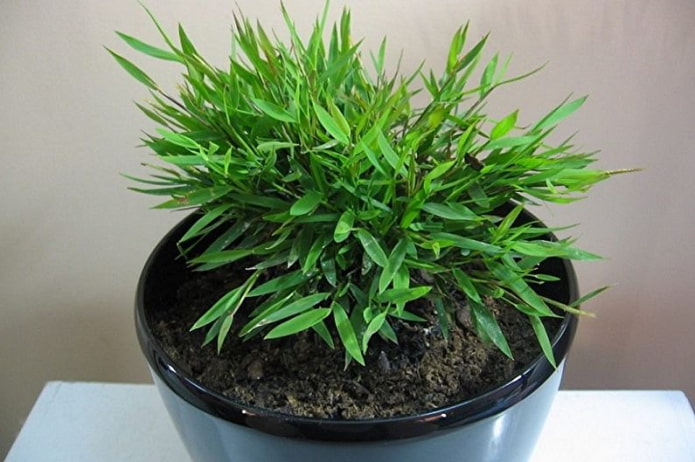
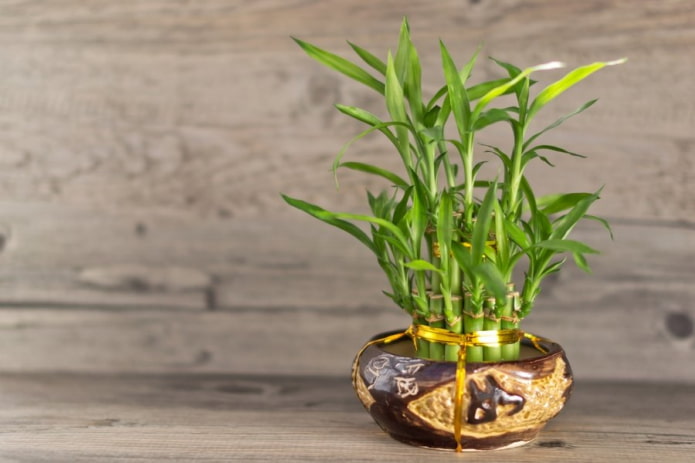

Medium-sized species
Feature – the bush grows up to 3-3.5 m in height. Medium varieties include:
- Mexican weeping bamboo. Its feature is long lanceolate leaves. Plastic flexible stems allow you to form original bush compositions. The root is well branched, grows vertically.
- Shiroshima – the variety stands out with a whitish-green color of the leaf blade. The base of the leaf is bright green. Whitish stripes located along the entire length give the indoor bamboo a decorative look. The plant has a powerful root, the shoots develop quickly even in water.
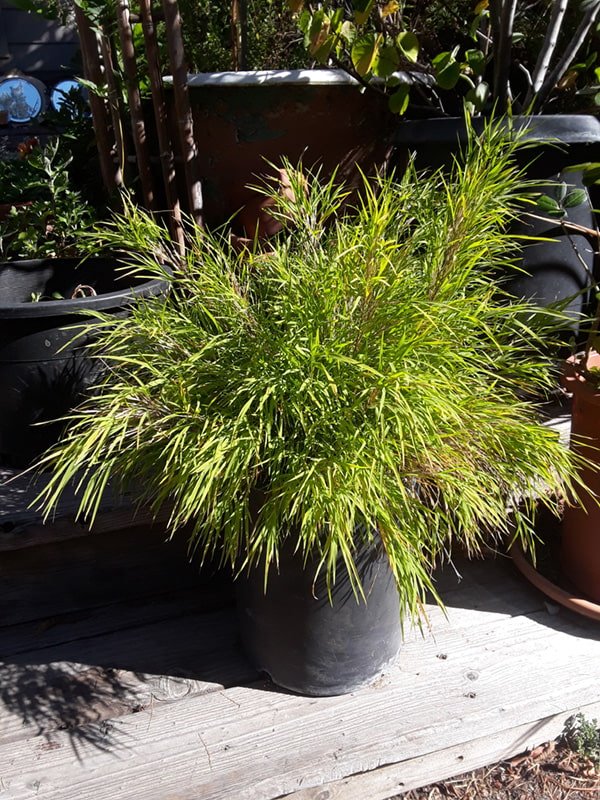
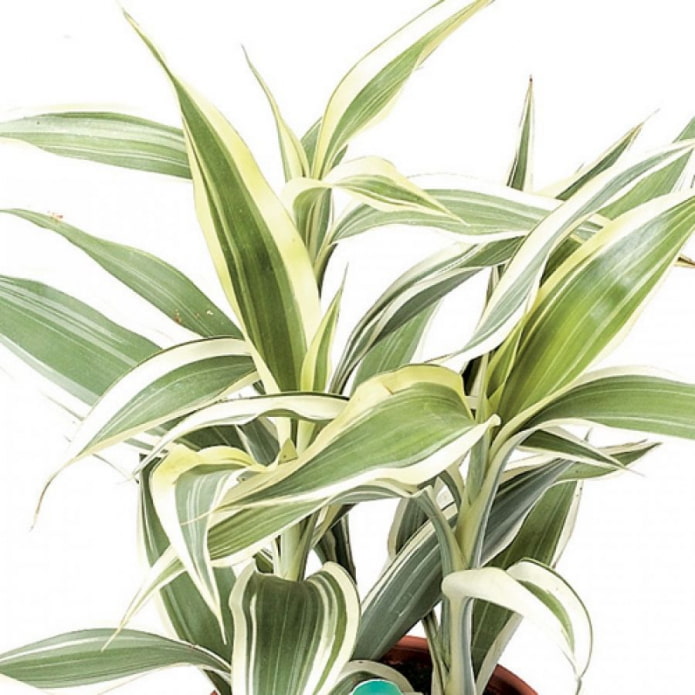
Tall varieties
The height of the bush is more than 5.5-6 m. The most popular species, but they are extremely rare in the interior:
- Multiplex Bambusa – a Chinese giant flower grows up to 6 m. The diameter of the central shoot reaches 4 cm. Shoots and sprouts are red. The trunks are rich yellow with greenish stripes and look original in spacious rooms.
- Giant woody bamboo is a heat-loving tropical plant. Its homeland is Taiwan. At home, the height of the bush is more than 5 m. The diameter of the shoot is 9-10 cm. The branches grow vertically, straight, the branches are short. The leaf blades are smooth, large, greenish in color.
- Tropical black bamboo is a light-loving plant native to Indonesia. The height of the bush is up to 6 m. The diameter of strong shoots is more than 8-9 cm.
- Monastic bamboo is a tropical variety that loves light and warmth. It withstands drought. Its homeland is Thailand, China. Small leaves give the plant an elegant appearance. Shoots are bright green.
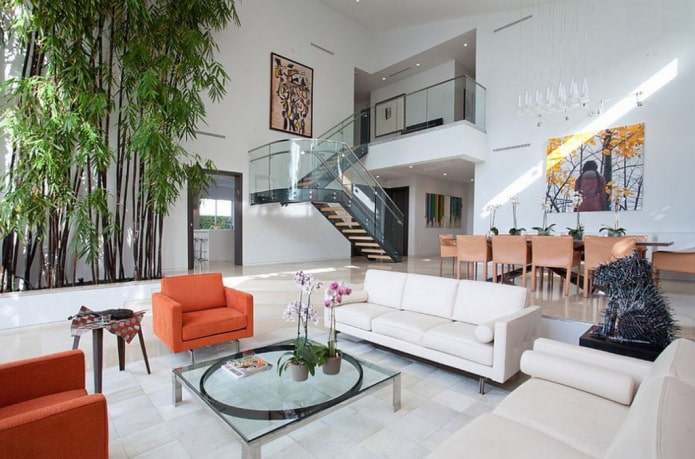
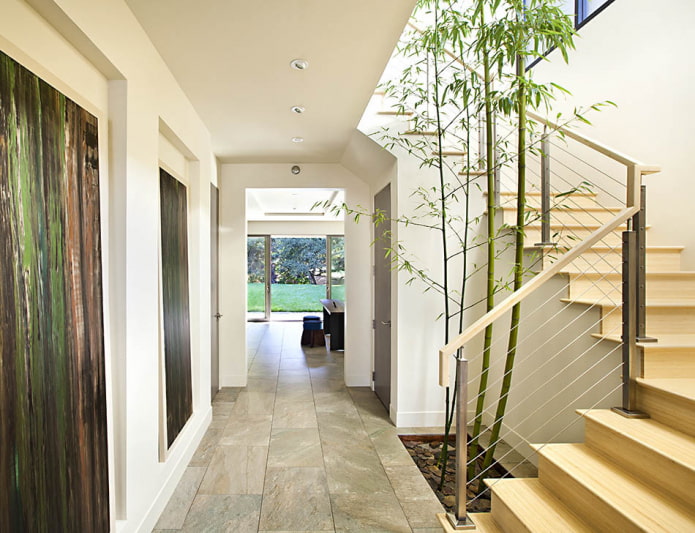
How to plant and propagate?
You can plant indoor bamboo in water or in soil.
The technology of planting in water is simple:
Attention! Use only soft water. For example, melted, purified or rainwater can be used to fill the container.
- select a container based on the size of the root and the height of the shoots;
- use glass or porcelain containers (glasses, flowerpots, wide bowls);
- place decorative stones and colored glass balls on the bottom of the container (for decorative purposes);
- fill the vase with water at room temperature;
- change the water once every 6-8 days;
- add special mineral fertilizers to the water once or twice every 2 months, depending on the period of plant activity;
- when the stems grow, transplant the plant into a floor vase or bucket.
To plant indoor bamboo in a pot, first prepare a special substrate and a container for planting. It is better for novice gardeners to buy a ready-made substrate for Dracaena or palms in specialized stores.
Step 1. Prepare the soil mixture
Substrate composition:
- coarse sand;
- high-moor peat;
- humus;
- turf soil;
- leaf soil;
- the ratio of ingredients is 1: 1: 1: 1: 1.
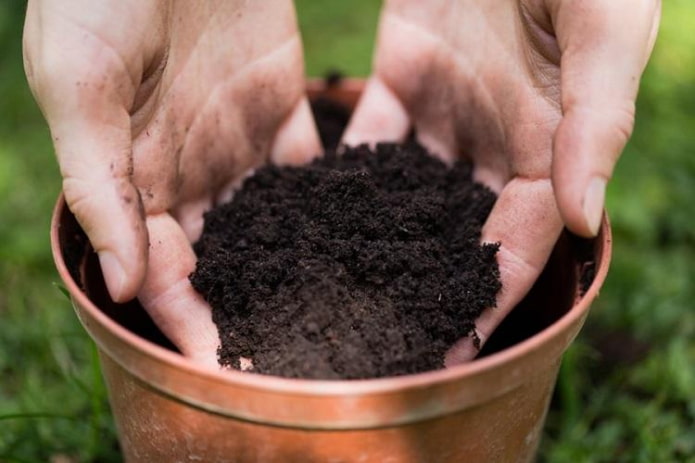
Important: to disinfect the substrate, calcine it in the oven or microwave.
Step 2. Prepare the planting capacity
In order for bamboo to grow quickly in a pot and produce offspring, you need to choose the right capacity. The main rule is that the size of the pot is chosen strictly according to the size of the root system. It is important to leave space between the root shoots and the walls of the container – at least 4-5 cm. As soon as the roots grow, the plant needs to be replanted. During the procedure, it is important to change the soil mixture.
Replanting times:
- young plants – 1-2 times a year (as the root system grows);
- 2-3 year old plants – once every 2-3 years.
Step 3. Planting
The procedure is not labor-intensive, even a novice gardener can do it:
- drainage holes are made at the bottom of the container for liquid drainage and good air permeability;
- disinfect the pot (with steam, boiling water, or treat with a special disinfectant solution);
- place pebbles, pebbles, small pieces of expanded clay on the bottom;
- pour slightly moistened soil mixture onto a third of the pot;
- make a wide hole in the center;
- carefully place the shoot in the center, straighten the root shoots;
- do not bury the root collar deeply;
- fill the voids with substrate;
- lightly compact the soil;
- water along the edge of the container as the substrate dries.
Indoor bamboo reproduces relatively easily. Several methods are used:
- Seeds. A long and labor-intensive process. The seeds quickly germinate after preliminary soaking on fabric or paper tape. Sprouted seeds are planted in separate small trays. The seeds are not buried deep, but sprinkled with a light substrate. The trays are covered with film (greenhouse effect). Seedlings require special conditions – constant warmth, good lighting, regular moisture, repeated picking. It is important to regularly ventilate the crops so that the moisture does not stagnate. Seedlings are picked after 2 months into small cups. Young shoots after the root system has grown are transplanted to a permanent place, one at a time or in a composition.
- The best method is cuttings. The procedure is carried out in the spring, after scheduled or formative pruning. Adult bamboo stems produce “offspring” – cuttings-shoots. They are carefully cut, the cuts are treated with crushed charcoal. The bases of the cuttings can be dipped in special solutions that stimulate the formation of root shoots. Planting cuttings are dipped in water for 1-2 weeks. As soon as the shoot puts out roots, it can be transplanted into special soil.
- Dividing the bamboo bush is done in the spring during transplantation. The method is only suitable for adult plants. The main rule is that each division should have buds and a well-developed root part.
Maintenance conditions
Domestic bamboo loves light, warmth, fresh air and light soil. Let’s dwell in more detail on the preferences of the tropical exotic and the peculiarities of keeping it in an apartment.
Light
Lighting should be moderate. The flower will feel discomfort under the scorching direct sun. At the same time, in the shade, bamboo leaves fade, shoots grow poorly, the plant withers and loses its decorative effect.
Location
It is better to install pots on western or eastern windows. In the midday heat of summer, it is advisable to cover the windows with a transparent light curtain, blinds or white paper.

Temperature conditions
Bamboo loves warmth. It is believed that Dracaena Sanderiana can withstand temperatures down to – 1. But you should not take risks – such experiments with sharp temperature fluctuations cause leaf fall. The optimal temperature range is 18-25.
Advice. A light shower or wiping the leaves with a damp cloth in the heat reduces the temperature by 4-5. Spraying and wiping the stems and leaves will also rid the plant of dust and dirt. This is an excellent preventive procedure that will protect bamboo from pests and diseases.
Air
It is important that the air in the room is moderately humid. For good health, the tropical inhabitant needs fresh air, so the room should be regularly ventilated.
- In winter, pots are removed away from batteries and heating devices.
- In summer, it is important that cold air flows from the air conditioner and fan are not directed directly at the plant.
- Drafts are also contraindicated.
Bamboo is an indoor plant, but fresh air will not harm it. Therefore, with the onset of constant heat, containers and pots are taken out to loggias and balconies.
Pruning Features
Sanitary pruning is necessary for any house plant. After flowering, when replanting, remove all dried parts – leaves, flowers. Before planting, be sure to inspect the root. Rotten, dry shoots are removed with sharp scissors. The cut sites are treated with special disinfectant solutions, varnish, ointment.
The easiest way is to sprinkle the “wound” with crushed pharmacy activated carbon.
Form-forming pruning of bamboo is carried out in early spring. Excess lateral and lower shoots are removed for thinning. As a result, a compact, neat bush with a beautiful crown grows. The cut shoots are used for rooting.
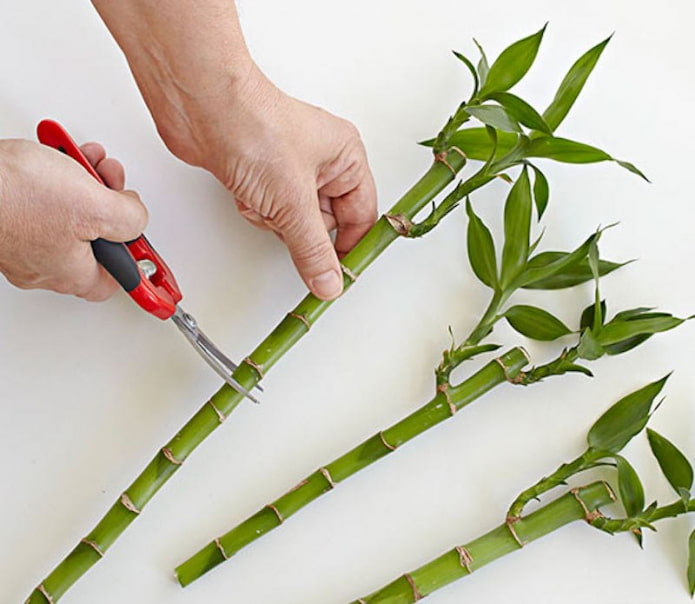
Attention! It is not necessary to remove fallen leaves. Such leaf layer is even useful for bamboo.
How to care for bamboo?
Nutrition and watering are important components of caring for an exotic plant. You cannot ignore its natural needs.
Feeding
When buying a seedling, you need to inquire what the exotic plant “ate”. You can consult a specialist about what mineral supplements the bamboo variety you have chosen prefers.
When planting, it is important to make a nutritious substrate. Replenishing supplies is easier than replenishing losses initially. It is known that ornamental plants do not develop well and get sick in poor and heavy soil.
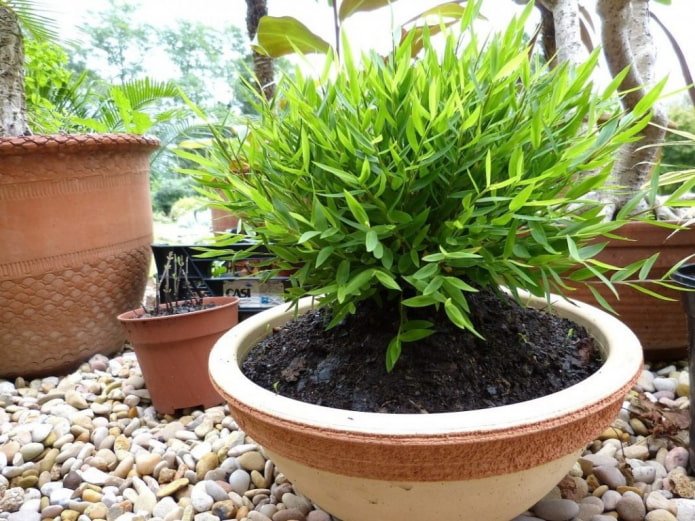
In the spring, nitrogen is important for the plant to build up green mass. Phosphorus additives are useful all year round for the growth and development of roots and stems.
Attention! The optimal soil acidity level is pH 6.0-6.2.
For plant feeding, use ready-made mineral complexes for Dracaena or palms:
- Master, for ficus and dracaena. You can use Master – a universal fertilizer.
- Activin (Actiwin) universal, Valagro – complex mineral fertilizer.
- White and Black – mineral (two-component) mixture for dracaena.
- Agrecol – mineral gel for dracaenas and palms.
Feeding regime:
- spring-summer – once every 3-4 weeks;
- autumn-winter – once every 2-3 months.
Watering
Moderation and caution – watering rules. The substrate should not dry out. But heavy clay soil with a high water content is also intolerable for bamboo.
Spraying from a fine sprayer, regular watering in small doses along the edge of the pot allows you to evenly nourish the roots, stems and leaves of the plant.
- In the summer, with a lot of moisture evaporation, bamboo is watered once a week.
- In autumn and winter – less often, as the top layer of soil dries out.
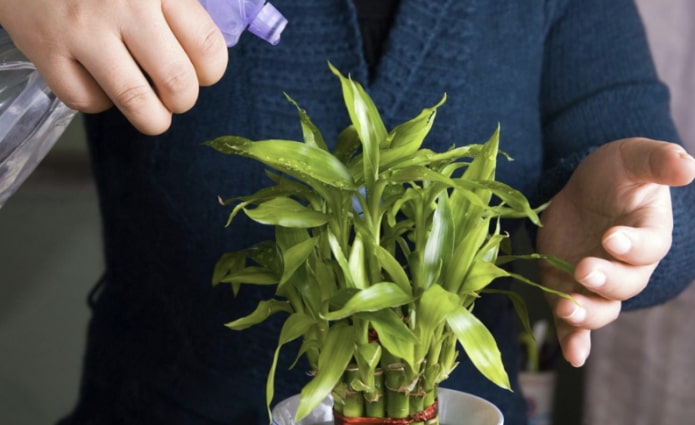
Parasites and diseases
Baby diseases mainly appear due to improper care of bamboo. The plant weakens, loses its immune abilities, and cannot resist harmful infections and bacteria.
Causes and effects of diseases:
- Excess liquid, stagnant water in the tray provokes rotting of the root system. Fungal rot appears. Bamboo leaves become dull and lose elasticity.
- When watering with cold hard water, the root can freeze. The plant sheds its leaves. It is important to lay a protective drainage layer on the bottom.
- The plant suffers from irregular or insufficient watering. The turgor of the leaf blade is lost, the leaves curl, the tips turn yellow and dry out. Moisture deficiency provokes the appearance of dry spotting.
- The leaves grow poorly, the annual growth of the stem is minimal – not enough light and nutrition. The plant absorbs minerals from the soil, fertilizers replenish the consumption and support growth forces.
- Excess of mineral or organic substances in the soil affects the uniform development of the bamboo bush. Leaves become deformed and curved. Do not exceed the permissible dosages or feeding regimen.

Fungicides will help prevent spotting, gray and root rot, and powdery mildew:
- Topaz;
- Colloidal sulfur;
- Previkur;
- Maxim;
- Baktofit, etc.
The most common pests of Dracaena Sanderiana:
- Spider mites appear if dust accumulates in the axils, on the leaves, and in the internodes. A simple way is to wipe the leaves and stem with a soap solution.
- The scale insect makes marks – brown spots appear on the leaves, reddish-yellow spots form around the plaques.
- The mealybug leaves whitish lumps on the surface of the soil, on the leaves (in the axils).
- Aphids are a dangerous sucking pest. Sticky drops of poisonous liquid remain on the leaves.
- Thrips are carriers of infection. The bush needs to be treated with Neoron.
Pests are collected mechanically with a swab soaked in special preparations – acetic acid, machine oil or alcohol. In advanced cases, the plant is quarantined. The top layer of the substrate is changed. Leaves and stems are treated with special systemic insecticides:
- Fufanon;
- Aktara;
- Agravertin;
- Fitoverm;
- Aktellik, etc.
How to twist the trunk?
A twisted or spiral bamboo stem is a design masterpiece. Due to the plasticity of the shoots, they are “curled” by stimulating the tilt of the plant stems towards the light source:
- the pot is placed in darkened vases or boxes with windows;
- the light (phytolamp) is directed into the window;
- the stem naturally tilts towards the light source;
- the resulting tilt is secured with a thick thread or wire;
- then turn the pot towards the light window – the stem tilts in the other direction;
- the place of tilt is fixed again.
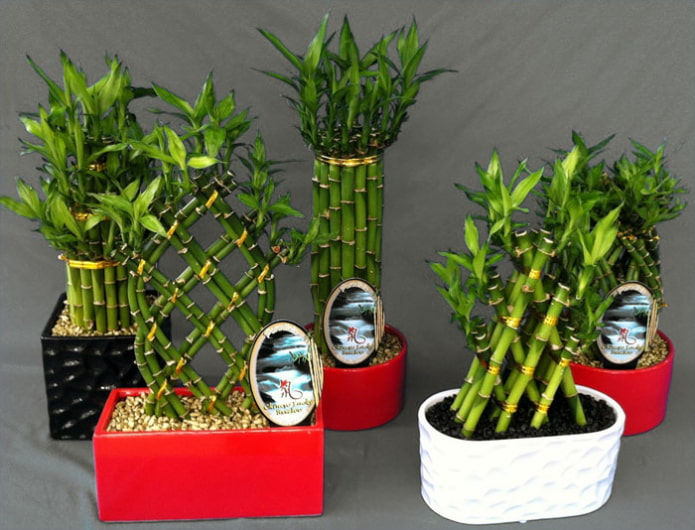
Growing a stem Sander’s dracaenas in a spiral is a rather painstaking procedure:
- a peg is installed next to the central shoot;
- the shoot is gradually twisted around the support-peg;
- to tighten the spiral, the bending point is fixed with twine, wire or rope.
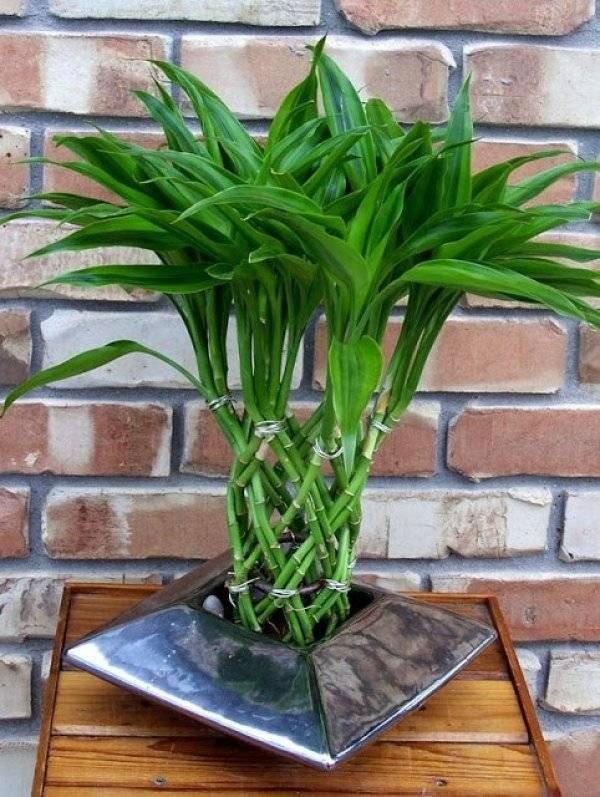
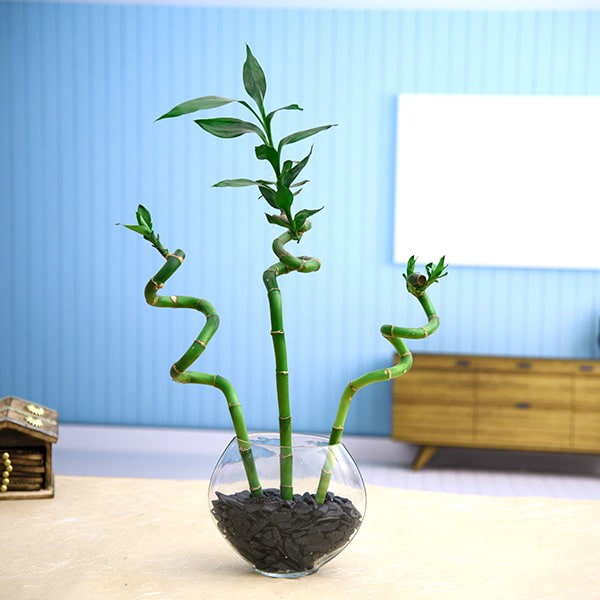
What does it look like in the interior?
Bamboo looks fashionable and stylish. This universal ornamental plant will decorate both a strict office, and a small room, and a spacious hall of a country mansion.
Group and single plantings of exotic look harmoniously in winter gardens, in compositions with other shrubs, ornamental plants in private living rooms.

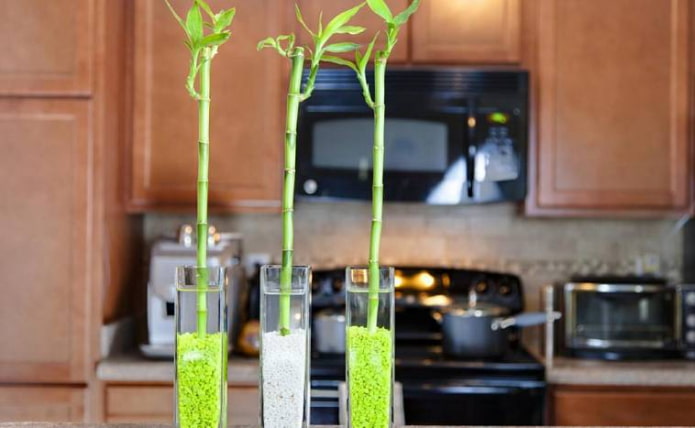
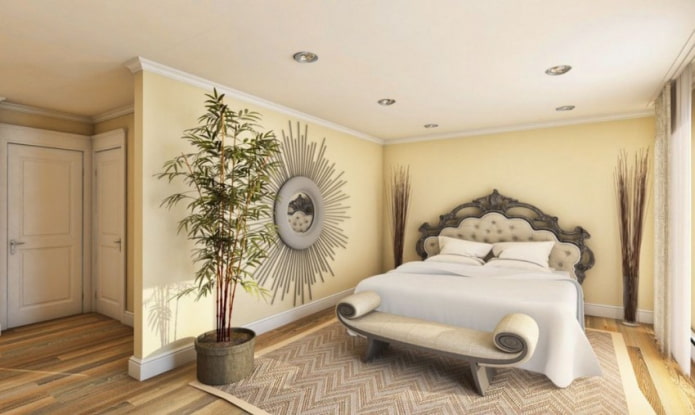
The tropical inhabitant grows well both indoors and outdoors. Massive giant varieties of bamboo are placed in stairwells.
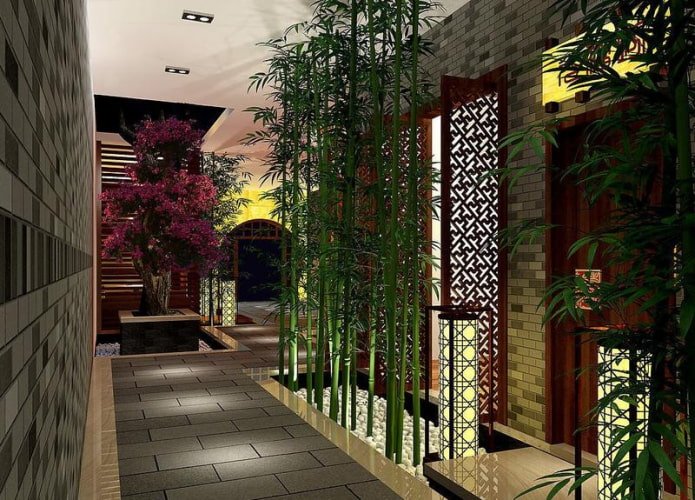
The bizarre spirals and living curls of the stems of this unique plant originally decorate any interior. Unpretentiousness, the ability of bamboo to smell in water and on land allow you to decorate narrow glass vases and even aquariums.
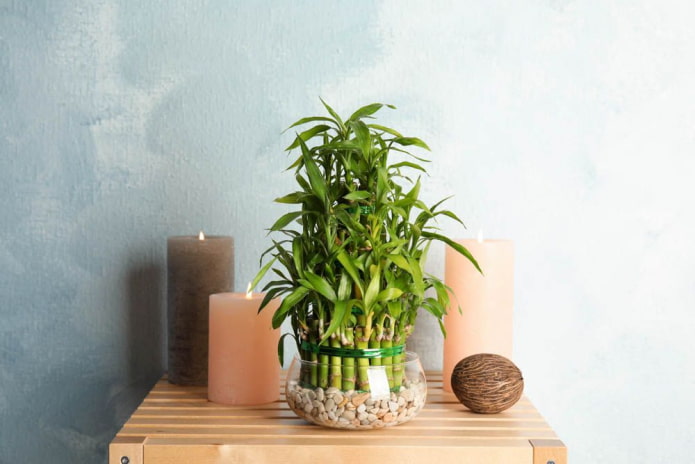
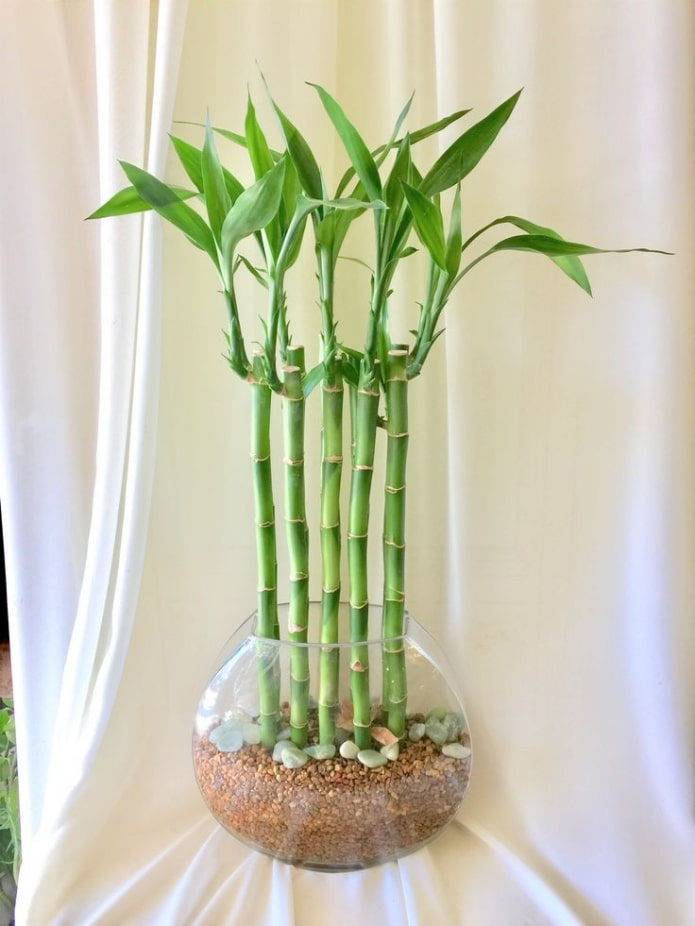
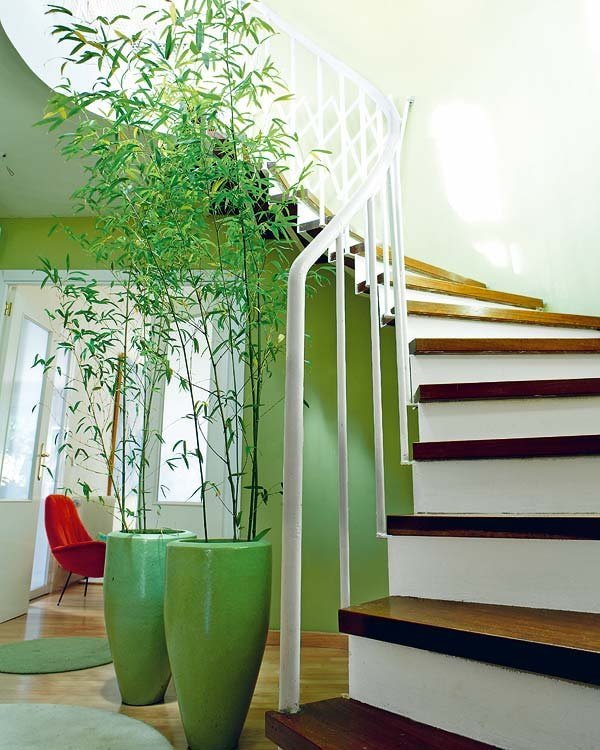
Live exotic thickets, compositions, hedges and walls are fantastic design finds for any, even the most sophisticated taste.
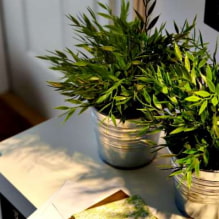
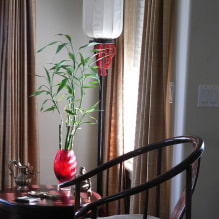
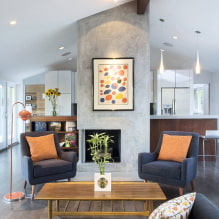
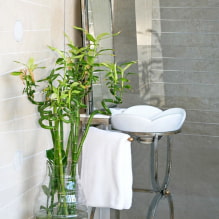
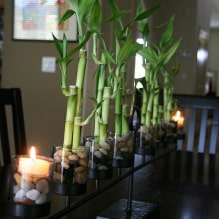
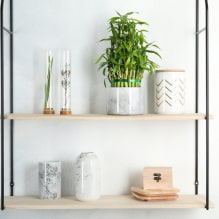
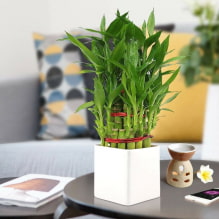
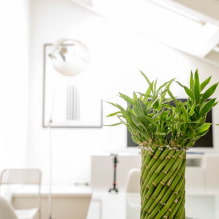
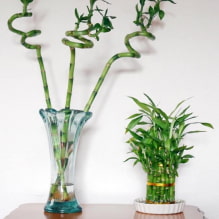
Now reading:
- Landscape design ideas and photos for a 6-acre plot
- Kitchen design with patina (36 photos) – color solutions, styles and examples of use.
- Kitchen interior with stone walls: 70 photos and current design ideas.
- Dividing wall for kitchen and living room: More than 60 photos and stylish solutions.
- Choosing a Kitchen Countertop Color: 60+ Inspiring Photos and Ideas.